“The physical planning of the new city reflects the harmony and integrated nature of its social structure. A unified planning approach assigns to each element a role in the formation of human environments.”
– The Ideal Communist City
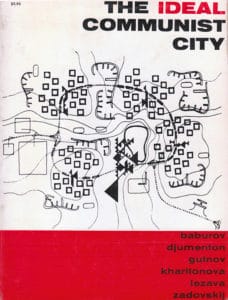 The Ideal Communist City by Alexei Gutnov, A. Baburov, G. Djumenton, S. Kharitonova, I. Lezava, and S. Sadovskij (Moscow University), Translated by Renee Neu Watkins, Preface by Giancarlo de Carlo
The Ideal Communist City by Alexei Gutnov, A. Baburov, G. Djumenton, S. Kharitonova, I. Lezava, and S. Sadovskij (Moscow University), Translated by Renee Neu Watkins, Preface by Giancarlo de Carlo
First written during the 1950s and translated from Italian to English in 1968, The Ideal Communist City (1968) is very much a product of its time. This does not only mean the ideological struggles of the Cold War (Capitalism vs. Communism… SPOILER ALERT! Capitalism won). It also means the symbolic height of propagating and implementing the principles of Modernist architecture and planning around the world. The principles discussed in The Ideal Communist City are merely a reformulation, repackaging and, yes, redistribution of these same ideas found in the new towns model (referred to here as the “New Unit of Settlement or NUS”) of Ebenezer Howard’s Garden Cities of To-morrow, housing models of Congrès internationaux d’architecture moderne (CIAM), and Harris and Ullman’s multi-nuclei theory in collusion with Euclidean zoning/modern transportation planning, which conveniently tells us almost any urban function can be randomly inserted almost anywhere in the city as long as ‘incompatible’ land uses are segregated.
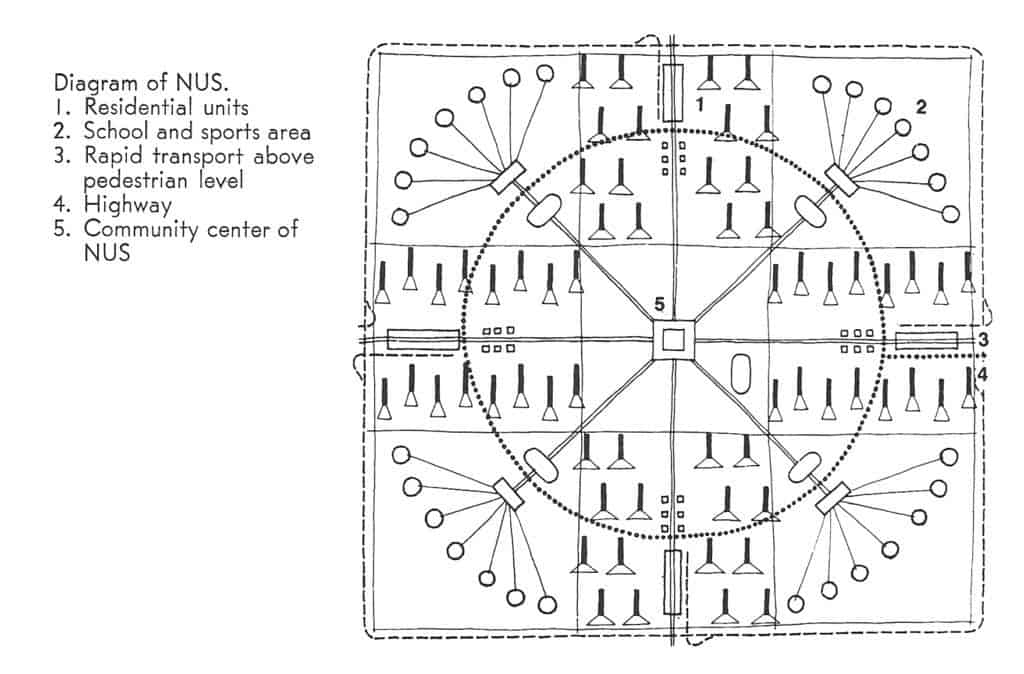 Of course, the key difference is the authors’ explicitly state the failure of these ideas to “reach their full potential” in Western societies is due to the corrupting influence of capitalism as a political and economic system. This is a conceit that has been badly exposed with time. If anything, capitalism more ruthlessly exploited the economic potentials of Modern ideas by taking them to their logical and, ultimately, extreme conclusion; probably more so than even most devoted CIAM architect ever imagined. The real danger about The Ideal Communist City is that younger readers (Millennials and generations thereafter) without any first-hand experience of the Cold War might make the mistake of thinking they are reading something original and entirely different because it’s wearing Soviet-era clothing. However, it is the same, tired planning paradigm we have been hearing about and (unfortunately) living with over the last 80+ years. To be fair, another key difference in this book is the desire of Soviet-era planners to adopt a model that segregates land uses from one another while still actively promoting manufacturing, mass production, and industrialization. Younger readers might also think this represents a somewhat unique perspective from the point of view of architecture and planning. However, it is really only evidence of Soviet preoccupation – even obsession – with Western societies’ manufacturing prowess at the time. In this sense, Soviet failure to compete with the success of Western capitalistic societies contradicted the ‘means of production’ arguments underpinning Karl Marx and Frederick Engel’s The Communist Manifesto and Marx’s Das Capital; that is, direct evidence that communism was a flawed political and economic system based on totalitarianism masquerading as a false ideology
Of course, the key difference is the authors’ explicitly state the failure of these ideas to “reach their full potential” in Western societies is due to the corrupting influence of capitalism as a political and economic system. This is a conceit that has been badly exposed with time. If anything, capitalism more ruthlessly exploited the economic potentials of Modern ideas by taking them to their logical and, ultimately, extreme conclusion; probably more so than even most devoted CIAM architect ever imagined. The real danger about The Ideal Communist City is that younger readers (Millennials and generations thereafter) without any first-hand experience of the Cold War might make the mistake of thinking they are reading something original and entirely different because it’s wearing Soviet-era clothing. However, it is the same, tired planning paradigm we have been hearing about and (unfortunately) living with over the last 80+ years. To be fair, another key difference in this book is the desire of Soviet-era planners to adopt a model that segregates land uses from one another while still actively promoting manufacturing, mass production, and industrialization. Younger readers might also think this represents a somewhat unique perspective from the point of view of architecture and planning. However, it is really only evidence of Soviet preoccupation – even obsession – with Western societies’ manufacturing prowess at the time. In this sense, Soviet failure to compete with the success of Western capitalistic societies contradicted the ‘means of production’ arguments underpinning Karl Marx and Frederick Engel’s The Communist Manifesto and Marx’s Das Capital; that is, direct evidence that communism was a flawed political and economic system based on totalitarianism masquerading as a false ideology
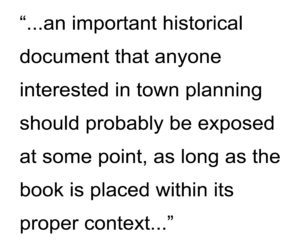 Having said all that, The Ideal Communist City is an important historical document that anyone interested in town planning should probably be exposed at some point, as long as the book is placed within its proper context for readers, especially post-Cold War ones. There are, in fact, relatively few flights of fancy in this book; the most amusing one being the common idea in science fiction that cities will eventually be covered by climate-controlled plastic domes (see Featured Image of this post at the top). The authors’ statistical projections of urban populations are way off, hilariously so. Early in the book, the authors project that 75% of the world’s population will live in urban areas by the year 2000 when it fact we only passed the 50% threshold in the last decade (due to the corrupting influence of capitalism, no doubt). The model of the NUS stretches believability despite the authors’ best – though somewhat halfhearted – efforts to address accommodating population growth during the transition period between one NUS being occupied and the next one being constructed. This is because these Soviet-era planners ultimately have a static view of the city. In hindsight, one might fairly argue the communist NUS model has already been better implemented and realized in cities such as Milton Keynes in England, the Pilot Plan of Brasilia in Brazil, or perhaps even some areas of America Suburbia, despite the problematic nature of such places as extensively discussed elsewhere in the literature. In the end, the Ideal Communist City is perhaps best at asking some interesting questions about cities but the answers provided are all too familiar and depressing to seriously contemplate. As Christopher Alexander famously said, “a city is not a tree.” It seems the same is as true for communist cities as it ever was for capitalistic ones. In the end, human nature is always more pervasive than any political ideology.
Having said all that, The Ideal Communist City is an important historical document that anyone interested in town planning should probably be exposed at some point, as long as the book is placed within its proper context for readers, especially post-Cold War ones. There are, in fact, relatively few flights of fancy in this book; the most amusing one being the common idea in science fiction that cities will eventually be covered by climate-controlled plastic domes (see Featured Image of this post at the top). The authors’ statistical projections of urban populations are way off, hilariously so. Early in the book, the authors project that 75% of the world’s population will live in urban areas by the year 2000 when it fact we only passed the 50% threshold in the last decade (due to the corrupting influence of capitalism, no doubt). The model of the NUS stretches believability despite the authors’ best – though somewhat halfhearted – efforts to address accommodating population growth during the transition period between one NUS being occupied and the next one being constructed. This is because these Soviet-era planners ultimately have a static view of the city. In hindsight, one might fairly argue the communist NUS model has already been better implemented and realized in cities such as Milton Keynes in England, the Pilot Plan of Brasilia in Brazil, or perhaps even some areas of America Suburbia, despite the problematic nature of such places as extensively discussed elsewhere in the literature. In the end, the Ideal Communist City is perhaps best at asking some interesting questions about cities but the answers provided are all too familiar and depressing to seriously contemplate. As Christopher Alexander famously said, “a city is not a tree.” It seems the same is as true for communist cities as it ever was for capitalistic ones. In the end, human nature is always more pervasive than any political ideology.
 The Ideal Communist City by Alexei Gutnov, A. Baburov, G. Djumenton, S. Kharitonova, I. Lezava, and S. Sadovskij (Moscow University), Translated by Renee Neu Watkins, Preface by Giancarlo de Carlo
The Ideal Communist City by Alexei Gutnov, A. Baburov, G. Djumenton, S. Kharitonova, I. Lezava, and S. Sadovskij (Moscow University), Translated by Renee Neu Watkins, Preface by Giancarlo de Carlo
Hardback, 166 pages
1968, Boston: George Braziller, Inc.
You can download a PDF of the full book for free here.
From the Vault is a series from the Outlaw Urbanist in which we review art, architectural and urban design texts, with an emphasis on the obscure and forgotten, found in second-hand bookstores.

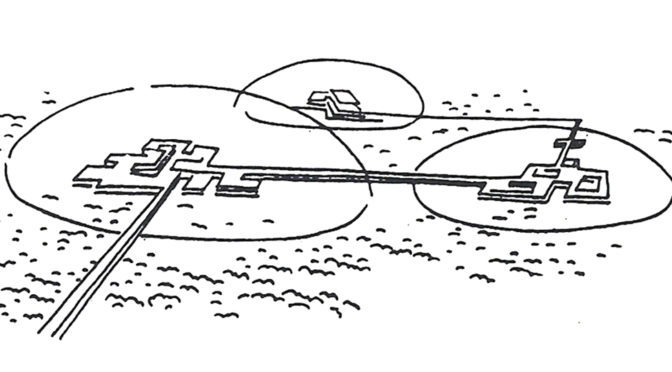

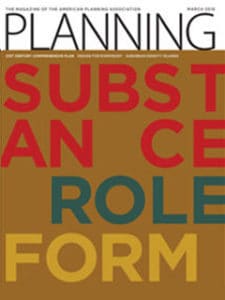 Planning Naked | March 2016
Planning Naked | March 2016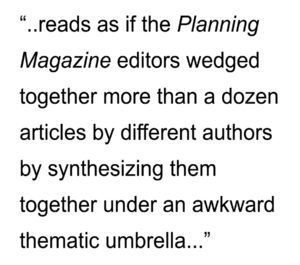 That’s not to say there aren’t good, interesting items in here (there are) but it’s a chore to sort through the mess and the constant “take (insert ‘community name/plan’ here)” asides are irritating in the extreme. It’s like someone composed a checklist, which can be re-constructed based on these paragraph ‘take this example’ asides. Let me try to help the readers: pp. 14-19 is ‘buzzword’ fluff that reads like a committee of marketing agencies wrote it (ignore it unless you find yourself in need of action verbs); pp. 20-24 (to the first 2 paragraphs) is outstanding because it demonstrates the re-emergence of design (e.g. form-based codes, etc.) as the real driver of new approaches to comprehensive plans and, in typical APA fashion, the awkward structure is designed to subvert the real story in order to re-assert (or, perhaps, soften the blow to) traditional planning approaches in the post-war period; the rest of the content (pp. 24-31) is mostly more planning fluff and buzzwords except for isolated excerpts here and there about PlanLafayette.
That’s not to say there aren’t good, interesting items in here (there are) but it’s a chore to sort through the mess and the constant “take (insert ‘community name/plan’ here)” asides are irritating in the extreme. It’s like someone composed a checklist, which can be re-constructed based on these paragraph ‘take this example’ asides. Let me try to help the readers: pp. 14-19 is ‘buzzword’ fluff that reads like a committee of marketing agencies wrote it (ignore it unless you find yourself in need of action verbs); pp. 20-24 (to the first 2 paragraphs) is outstanding because it demonstrates the re-emergence of design (e.g. form-based codes, etc.) as the real driver of new approaches to comprehensive plans and, in typical APA fashion, the awkward structure is designed to subvert the real story in order to re-assert (or, perhaps, soften the blow to) traditional planning approaches in the post-war period; the rest of the content (pp. 24-31) is mostly more planning fluff and buzzwords except for isolated excerpts here and there about PlanLafayette.
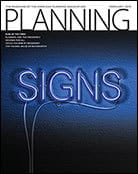 Planning Naked | February 2016
Planning Naked | February 2016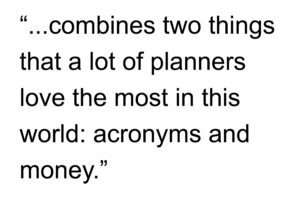 “A Transportation Bill, At Last” by Jon Davis (pp. 8-9) is combines two things that a lot of planners love the most in this world: acronyms and money. Here’s the long and short of the Fixing America’s Surface Transportation Act (FAST Act… oh, a cool acronym… that must mean it’s important because it’s fast!): for every $1 spent on the automobile (e.g. roads), the US Government is spending 0.24¢ on buses and 0.04¢ on passenger rail. It must be great to be a Washington lobbyist for the ‘automobile cartels’. To quote a song from the 1977 Disney film, Pete’s Dragon, it’s “money, money, money by the pound!” “He that is of the opinion money will do everything may well be suspected of doing everything for money.” – Benjamin Franklin
“A Transportation Bill, At Last” by Jon Davis (pp. 8-9) is combines two things that a lot of planners love the most in this world: acronyms and money. Here’s the long and short of the Fixing America’s Surface Transportation Act (FAST Act… oh, a cool acronym… that must mean it’s important because it’s fast!): for every $1 spent on the automobile (e.g. roads), the US Government is spending 0.24¢ on buses and 0.04¢ on passenger rail. It must be great to be a Washington lobbyist for the ‘automobile cartels’. To quote a song from the 1977 Disney film, Pete’s Dragon, it’s “money, money, money by the pound!” “He that is of the opinion money will do everything may well be suspected of doing everything for money.” – Benjamin Franklin
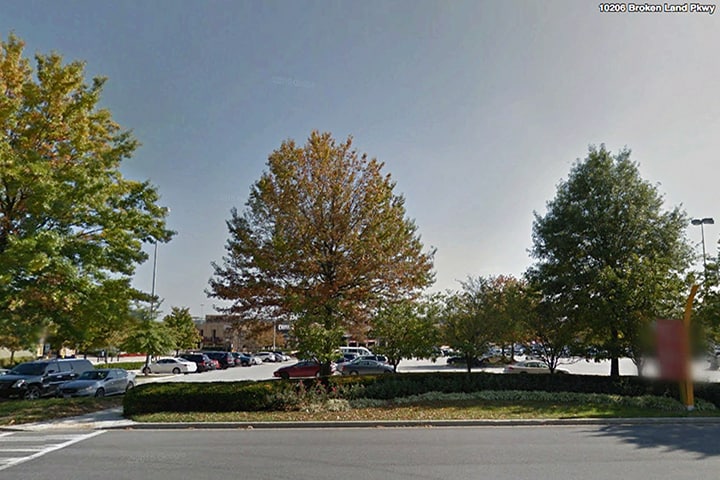
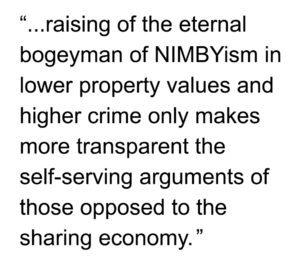 The raising of the eternal bogeyman of NIMBYism in lower property values and higher crime only makes more transparent the self-serving arguments of those opposed to the sharing economy. Let’s fight for the normal, not the abnormal created in 1926 by the U.S Supreme Court.
The raising of the eternal bogeyman of NIMBYism in lower property values and higher crime only makes more transparent the self-serving arguments of those opposed to the sharing economy. Let’s fight for the normal, not the abnormal created in 1926 by the U.S Supreme Court.
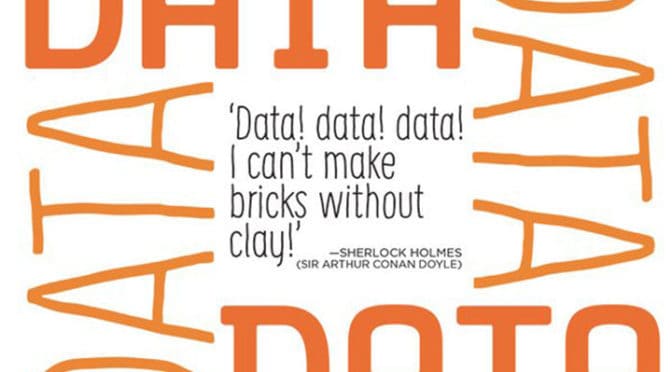
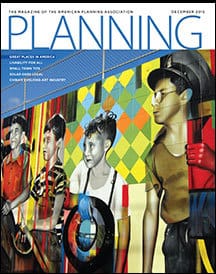 Planning Naked | December 2015
Planning Naked | December 2015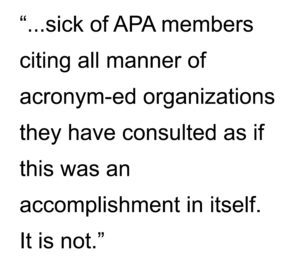 Consultation is an activity (a means to an end) and not an accomplishment in itself. Personally, I’m sick of APA members citing all manner of acronym-ed organizations they have consulted as if this was an accomplishment in itself. It is not. Poor Richard: It isn’t the quantity of the acronyms that matter but the quality of their (letter) characters. APA members need to be careful about flying to something shiny (AARP’s Livability Index, e.g. Won’t someone please think of the old people?!?!) and applying it without thought before understanding its underlying assumptions. Count me suspicious. Based on experience,
Consultation is an activity (a means to an end) and not an accomplishment in itself. Personally, I’m sick of APA members citing all manner of acronym-ed organizations they have consulted as if this was an accomplishment in itself. It is not. Poor Richard: It isn’t the quantity of the acronyms that matter but the quality of their (letter) characters. APA members need to be careful about flying to something shiny (AARP’s Livability Index, e.g. Won’t someone please think of the old people?!?!) and applying it without thought before understanding its underlying assumptions. Count me suspicious. Based on experience, 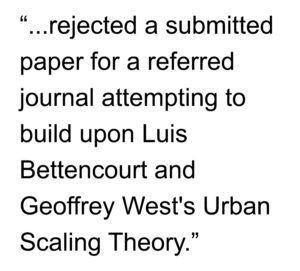 I can’t really comment with authority on the validity of Ewing’s arguments since I have not read the submitted paper in question. Of course, Ewing is correct that the larger the city, the more you have of everything including crime. The aggregated population v. crime correlation is interesting at an abstract level (and should be totally expected) but not very useful for planning policy. For that, you need the sensitive street-by-street and block-by-block modeling techniques of the urban network such as space syntax. In this way, you can demonstrate the usefulness of such correlations between population, crime, location/access, and spatial vulnerability and potential proposed design changes to address the problem. There’s a lot of good research on that front. However, what is refreshing about Ewing’s article is the transparency. It is an excellent attempt to ‘unveil’ the scientific process at work. In this sense, it is very valuable. In fact, Ewing’s article makes me wonder whether there is some inherent value in all referred publications printing short summaries by referees for all rejected papers so that the entire scientific, urban planning community can benefit from seeing the process at work. Something worth thinking about as this could be ‘a rising tide lifts all boats’ type of strategy.
I can’t really comment with authority on the validity of Ewing’s arguments since I have not read the submitted paper in question. Of course, Ewing is correct that the larger the city, the more you have of everything including crime. The aggregated population v. crime correlation is interesting at an abstract level (and should be totally expected) but not very useful for planning policy. For that, you need the sensitive street-by-street and block-by-block modeling techniques of the urban network such as space syntax. In this way, you can demonstrate the usefulness of such correlations between population, crime, location/access, and spatial vulnerability and potential proposed design changes to address the problem. There’s a lot of good research on that front. However, what is refreshing about Ewing’s article is the transparency. It is an excellent attempt to ‘unveil’ the scientific process at work. In this sense, it is very valuable. In fact, Ewing’s article makes me wonder whether there is some inherent value in all referred publications printing short summaries by referees for all rejected papers so that the entire scientific, urban planning community can benefit from seeing the process at work. Something worth thinking about as this could be ‘a rising tide lifts all boats’ type of strategy.
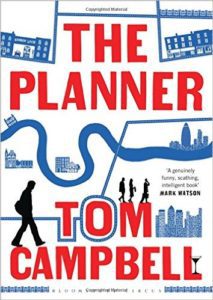
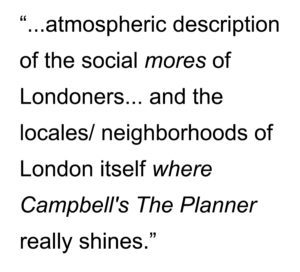 The personal revelations in The Planner are hardly surprising (people are not always as they appear) or earth-shattering (people are stupid and need to be told what to do, i.e. what one might expect from someone choosing town planning as a profession). This is especially true since it’s readily apparent this is the worldview James already holds at the start of the story, so acute self-awareness is the only lesson he learns on this journey. However, it is the atmospheric description of the social mores of Londoners (including lingering remnants of the class system) and the locales/neighborhoods of London itself where Campbell’s The Planner really shines. This includes all-too-familiar witty commentaries on the dreariness and inherently self-defeating proposition of the town planning profession itself in the absence of naked tyranny. Some of it is very cynical (e.g. everything is branding). You may not be entirely satisfied where The Planner ends up but you’ll enjoy the journey getting there, which so often describes what the city is really all about (3 1/2 stars out of 5).
The personal revelations in The Planner are hardly surprising (people are not always as they appear) or earth-shattering (people are stupid and need to be told what to do, i.e. what one might expect from someone choosing town planning as a profession). This is especially true since it’s readily apparent this is the worldview James already holds at the start of the story, so acute self-awareness is the only lesson he learns on this journey. However, it is the atmospheric description of the social mores of Londoners (including lingering remnants of the class system) and the locales/neighborhoods of London itself where Campbell’s The Planner really shines. This includes all-too-familiar witty commentaries on the dreariness and inherently self-defeating proposition of the town planning profession itself in the absence of naked tyranny. Some of it is very cynical (e.g. everything is branding). You may not be entirely satisfied where The Planner ends up but you’ll enjoy the journey getting there, which so often describes what the city is really all about (3 1/2 stars out of 5).